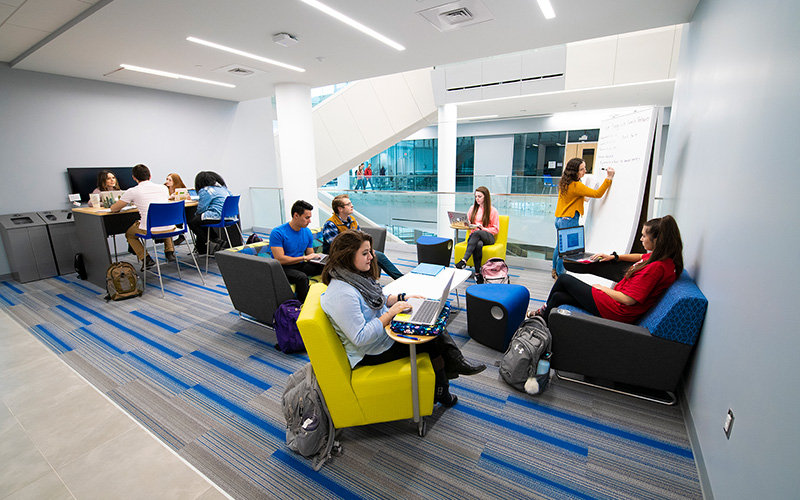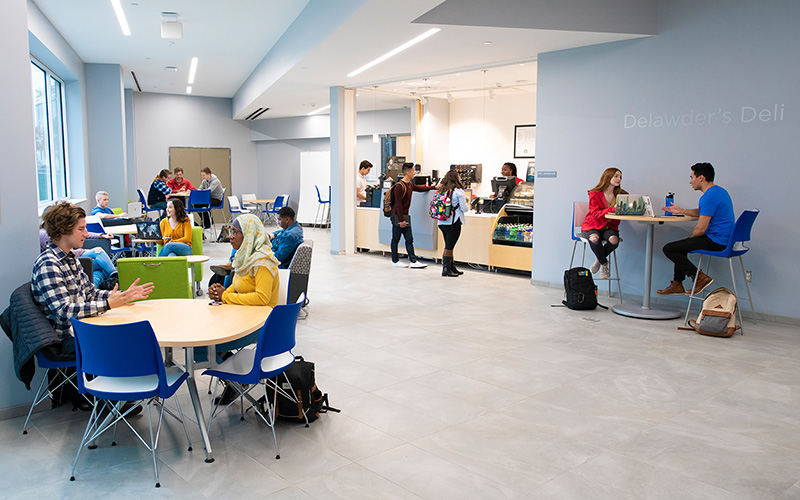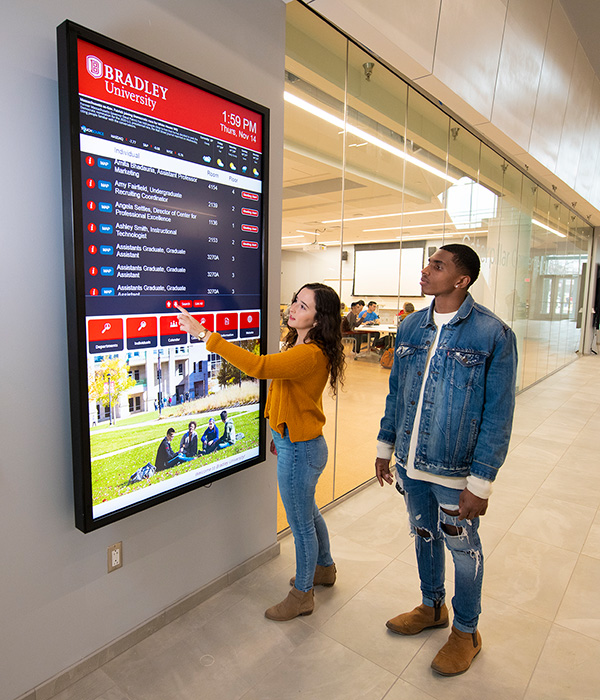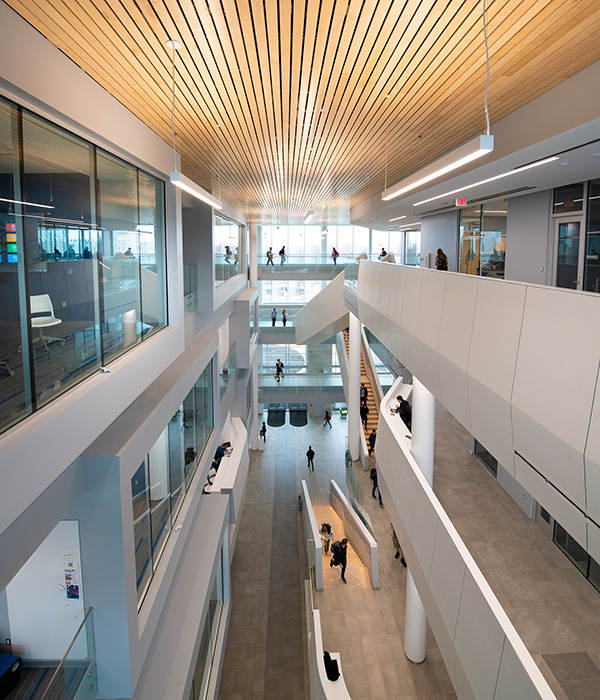WATCH COMMENCEMENT LIVE ON SATURDAY, DECEMBER 14.
Livestream access begins at 9:15 a.m.
In this long-anticipated campus building, convergence is the name of the game.
Imagine...
A cleaning, disinfecting and mapping robot;
Physical therapy applications that study posture to treat back pain better;
A more robust web presence for small, local businesses, giving them more customers and visibility, as more people take their shopping and dining experiences online.
These are among the myriad projects at the new Business and Engineering Convergence Center, which, even having its first full semester with students cut short by the COVID-19 pandemic, brings different disciplines and majors together to discover or create solutions.
While students, faculty and staff started moving in during fall 2019, several months later the global pandemic created a new normal. One year later, masked students walked through the soaring entryway, professors held remote and in-person classes, while labs provided hands-on application for classroom learning.
To further encourage convergence, the 200,000-plus-square-foot structure includes 40-plus collaboration spaces, 10 formal conference rooms, 28 classrooms, eight computer labs and 200 faculty and staff offices. Forty-six specialized labs include a five-story drop tower for experiments to measure impact conditions, a sales lab for business role-playing and an analytics lab with a 5-foot by 31-foot, high-definition monitor and two electronic stock tickers.
“The technology throughout the building, and especially in the classrooms, provides a more interactive and collaborative student experience,” said Heidi Baumann MBA ’08, associate professor of management. “It enables cutting-edge teaching methods that support experiential learning.”
The university’s largest building project ever, the BECC brings under one roof the Foster College of Business and the Caterpillar College of Engineering and Technology, along with the Institute for Innovation through Collaboration.
“For lecture-based courses …students will have real-time understanding with the help of lab instruments,” said Yufeng Lu, associate professor and interim chair of the electrical and computer engineering department. “For lab-based courses, instructors can address common problems through lectures. It will make lab courses more efficient.”
Specialized classrooms allow for interaction and collaboration between students, faculty and even with the community. Peoria’s Main Street corridor runs past the building, allowing for participation from residents and boosting the university as an innovator.
“I’ve always appreciated Bradley’s focus on collaboration and now it’s apparent how committed we are to it. In the real world, engineering and business have to work together to make enterprises thrive, and now we’re able to get a lot more hands-on experience with this,” said Elijah Hunt ’22, who’s in the 3:2 accounting program and on an eight-person team working on a convergence project with Morton Industries.
1 video wall
151 flat panels
2 electronic stock tickers
Students from throughout the university are heavily involved in the building’s makerspace, which allows people to work on new products and ideas. A student board will help select and train others on equipment for the space, determine an operating plan and budget, establish hours and hire workers.
“Every day I’m in the building I see students — not just from our two colleges — working together, learning from each other and developing lasting friendships,” said marketing instructor Brad Eskridge ’08.
With 600 seats in faculty and staff areas, along with 1,500 student seats, there are plenty of opportunities for interaction, even with physical-distancing rules in place.
“Now that we are in the space, I think differently about learning opportunities and initiatives,” said Jennifer Robin, professor of management and leadership and associate dean of the Foster College of Business. “I can tell others do as well. When it comes to creativity, there is really no substitute for incidental collisions with people outside our typical circles.”
“It is a fabulous building with amazing technology … and it provides multiple ways of teaching,” said Jing Wang, associate professor of electrical and computer engineering. “I also enjoy the faculty lounge, which creates a nice opportunity for discussion among colleagues.”
There’s an additional advantage from the building’s state-of-the-art equipment and technology, according to electrical and computer engineering major Ryan Russell ’21.

“Having the advanced technology at our disposal is a substantial attraction to the facility,” said Michael Bianchi ’21.
51 projection screens

Getting together in a study area or Delawder’s Deli bonds students, faculty and staff.
2,100+ seats
3,040 tons of steel
28,400 sq. ft. of glass
4 elevators

Handy wayfinding stations make navigating the spacious building’s levels easier. “The building is impressive,” said Baumann. “The design enables collaboration in so many ways.”
3 wayfinding displays

8 digital room schedule displays
560 stairs

For a 360-degree view, visit bradley.edu/becctour
“This will help Bradley’s strong professors shine. If the BECC does anything for Bradley, I believe it should help professors be their best selves.”
Along with linking different disciplines and courses, the Turner Center for Entrepreneurship reaches out to the community through classes and workshops for those developing or growing their own businesses. One of its latest projects aims to help small, local businesses increase their online presences along with work on cybersecurity. An example of this is restaurants putting their menus and ordering procedures online.
Other research has a global outlook. Suruz Miah, assistant professor of electrical and computer engineering, has a student who’s developing a robot that cleans and disinfects areas using UV light and a disinfectant sprayer. This makes it safe to use when humans or animals are present in a room.
A multisemester senior capstone for students in user experience design partners with Jump Trading Simulation and Education Center at OSF and the University of Illinois College of Medicine at Peoria. It draws on several areas — physical therapy, marketing, game design and possibly, in the future, mechanical engineering. The project aims to develop a smart posture app that tracks a patient’s posture to improve back pain and make it easier for a physical therapist to treat a person remotely.
Various other projects involve research into algorithms to control multiple robots and radio frequency circuit design for charging wireless devices, among others.
“The traditional areas of engineering have matured, while there are a number of emerging areas at the convergence of engineering with other disciplines like business, computer science, basic sciences and health sciences,” said Ahmad Fakheri, professor of mechanical engineering. “The concept of convergence has broadened beyond engineering and business to a collaborative approach to learning across traditionally independent disciplines.”
While forward-looking in uniting different disciplines across campus, the BECC also honors two longtime Bradley legends — one from business and one from engineering. Sculpture professor Fisher Stolz created a statue of economics professor and provost Kal Goldberg that stands near the front atrium. A portrait done by the late Bill Hardin ’50 of the late Martin Abegg ’47 HON ’93, a former Bradley president who served as dean of the engineering faculty, is also installed.
Unlike its more utilitarian predecessors — Jobst and Baker halls — the new building’s soaring, open design draws praise. “I like the openness of the building, especially the big glass windows facing the quad,” said Assistant Professor Mohammad (Imran) Hossain of the civil engineering and construction department.
“There are so many things I like about (the building) but one thing I like the most is that my office is bright and roomy, especially the height of the ceiling,” agreed Jason Jiao, accounting assistant professor.
Multiple study areas are found throughout the building along with a unique amenity: Delawder’s Deli, located inside the BECC’s campus-side entrance, which offers sandwiches and snacks, as well as coffee and other drinks.
“The large amount of study spaces right outside the classrooms makes it easy to find time for a quick study session before heading to class,” said marketing major Adam Klein ’21.
“Plus, who doesn’t love access to coffee without having to leave the building?” asked Baumann.
— with reporting from Mary Brolley
Post Your Comments